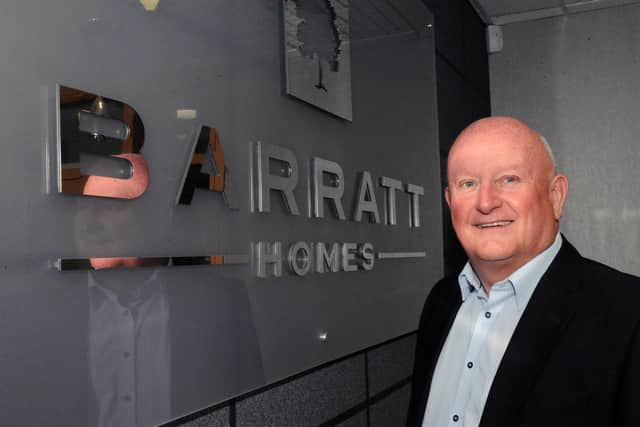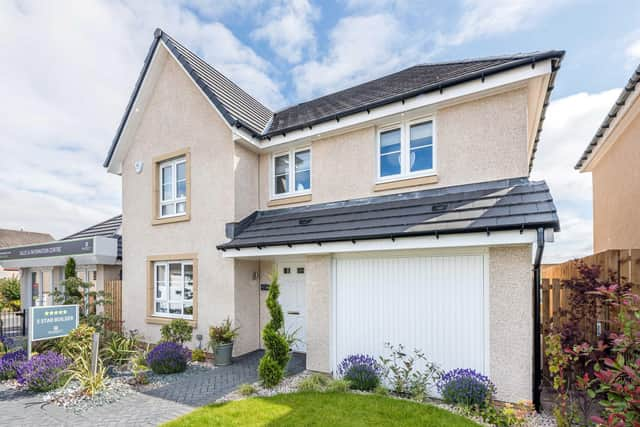The Big Interview: Doug McLeod, Barratt Developments' regional MD for Scotland
The group notes that it has served the Scottish homes market for almost 50 years, adding that in 2020/21 it sold out at several sites across Scotland for example, including The Limes in Edinburgh, and Victoria Grange, Monifieth.
Mr McLeod said in March regarding the 12 months ending June 30 last year: “Despite the challenges of 2020, we’re proud to have delivered over 1,300 new homes to Scottish buyers and boosted the economy by £245 million.”
Advertisement
Hide AdAdvertisement
Hide AdIn 2021/22 it will deliver site launches including Findrassie in Elgin and Kingslaw Gait in Kirkcaldy, while its key focus will be the continued expansion of the David Wilson Homes brand north of the Border.


The group started out in the 1950s after the young Sir Lawrie Barratt couldn’t afford to buy the house he wanted so built one himself – a four-bedroom home in Newcastle-upon-Tyne that cost £1,750.
The firm listed on the London Stock Exchange in 1968 and said in its most recent trading update that it expected to increase wholly owned completions to between 16,000 and 16,250 homes this year. “Despite the continued economic uncertainties, the housing market fundamentals remain attractive,” it also stated.
Can you explain what your role as regional managing director for Scotland entails – and what your goals are?
Strategy. My job is to grow the business to have a sustainable future; as a result I spend a great deal of my time reviewing policy for the future growth based on information, evolving trends and experience.


I am responsible for the smooth operation of the four divisions that operate throughout Scotland. A typical month for me would be board meetings to review financial performance, production, quality standards and opportunities to grow the business.
We are the largest housebuilder in Scotland and my goal is to develop the business even further for our people and for homebuyers. Using the recent acquisition of Oregon Timber as an example, we have expanded its capacity and output, which has resulted in more jobs and has helped to address the timber frame shortage.
Making strategic decisions like this one provides assurance for the 2,500 people who work with us and the people who will go on to live in a Barratt Home. My continued focus is in promoting a planning system that will secure land for the provision of new homes throughout Scotland.
Advertisement
Hide AdAdvertisement
Hide AdHow has Barratt adapted to the pandemic? You’ve not laid off any staff, and repaid all furlough support, for example – but also what challenges have the outbreak posed?
We adapted to the challenges very quickly. The first one was to get all the IT equipment needed to enable our office staff to work from home. The next big challenge as we prepared to come out of lockdown was to get our sites and sales teams trained and ready to work in a safe environment with safe operating procedures.
It was crucial that we got this right because our number one priority was to provide a safe and secure working environment for all our colleagues. This we managed thorough forward planning following health and safety along with Scottish Government guidelines. As well as the physical wellbeing, we knew it was equally important to consider the mental wellbeing of our employees.
I am proud that we already had a team of people who were trained in Mental Health First Aid (MHFA) before the pandemic hit. We have grown this team fivefold and they have supported our people throughout lockdown, encouraging them to take breaks, talk to each other and embrace light exercise. We now have 50 trained MHFAs working across our Scottish business. There is at least one MHFA on every site.
The next challenge is to help our teams transition back to working in an office environment, on a rota basis. We have allowed staff to return to offices, up to a 20 per cent maximum capacity.
Over the last 16 months, the way in which people work and indeed expect to work in the future has changed. As we encourage people to return to the office, we shall ensure that they feel safe and comfortable to do so. For the re-opening of offices, we are following health and safety along with Scottish Government guidelines, which shall be developed to enable greater flexibility for working.
A focus I have is to ensure that we provide the best opportunities for our employees and trainees to gain experience in our business. Whilst we have provided online and remote training during the pandemic, this is no substitute for working alongside colleagues, which is key to their development and success. The snippets of information acquired from being in the office are crucial for their development.
Can you characterise the way lockdowns have changed what homebuyers are looking for – and how that is affecting your bottom line?
Advertisement
Hide AdAdvertisement
Hide AdMost people are looking for larger houses for home working, which has helped stimulate the housing market. The concern we had coming out of lockdown was the uncertainty of what the future would hold; people were worried about their future and buying a new home was understandably not a priority at that time.
However, since coming out of lockdown the market has been very strong and is thriving. During lockdown we also had people view and purchase their home entirely by a virtual experience, which demonstrates the importance of technology and the part it has played in the past year. Now we’re welcoming them back to our show homes.
We have also been recruiting. We have taken on 25 apprentices this year and last as well as five graduates and we are looking to hire more.
As well as the Oregon Timber acquisition, and invested £500,000 in new plant and equipment to support future growth. Do you have plans to make more such moves – including further potential acquisitions?
We have no plans for future acquisitions. As part of the acquisition of Oregon, the challenge was to integrate it fully into our business and provide timber kits for all of our sites. This was realised through creating efficiencies in the design. We have now increased our capacity and extended our geographical area of operation, to supply kits to North-east England and Yorkshire.
You joined the group in 1974 – what led you to join the business and how did your career progress to your current role?
I worked in an office and when the Barratt job came up I saw it as an opportunity to go to an organisation that had a more hands- on approach and was multi-disciplined. It was also a chance to learn and grow. My first role at Barratt was as a quantity surveyor, then I was promoted to chief surveyor, then technical director, followed by managing director, and finally regional managing director for Scotland.
The year you started at Barratt, the average price of a UK home in the second quarter was £10,027 – but in the same period this year it was £242,709, according to figures from Nationwide. What is Barratt doing to help first-time buyers get onto the ladder and how can the problem of affordability be addressed more broadly?
Advertisement
Hide AdAdvertisement
Hide AdBarratt has designed a range of homes well-suited to first-time buyers – 25 per cent of the homes we build are affordable and suit them. We do have various incentive schemes to encourage first-time buyers into the market, including Golden Share, which is backed by City of Edinburgh Council and is an affordable housing scheme for eligible first-time buyers and existing homeowners, which allows them to purchase a new home at only 80 per cent of its market value.
We also have the Armed Forces Deposit Contribution scheme, which is an exclusive deposit scheme for servicemen and women and their families, offering them a 5 per cent deposit, up to £15,000. We also run development-specific schemes, such as 5 per cent deposit boosts, which allow people who have saved 10 per cent to reduce the overall cost of borrowing.
To assist first-time buyers, if more land was released through the planning system this would reduce the cost of new homes.
Barratt has said it fully expects the business to return to pre-Covid levels by the end of the 2021/22 business year. How does it aim to achieve this – and mitigate rising build costs that it flagged in May?
Our first step was to secure the land to enable us to build the volume of new homes at pre-Covid levels. We have improved the design of our timber kits and our homes to provide efficiencies and this has been completed in collaboration with Oregon, which has helped reduce the impact of rising material costs. Our timber kit homes are more sustainable and well-insulated, lowering the running cost for the homeowner.
A message from the Editor:
Thank you for reading this article. We're more reliant on your support than ever as the shift in consumer habits brought about by coronavirus impacts our advertisers.
If you haven't already, please consider supporting our trusted, fact-checked journalism by taking out a digital subscription.
Comments
Want to join the conversation? Please or to comment on this article.
